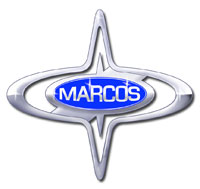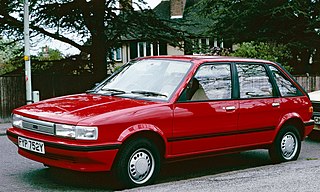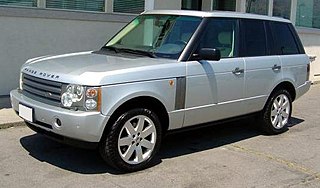
The Mini is a small, two-door, four-seat car, developed as ADO15, and produced by the British Motor Corporation (BMC) and its successors, from 1959 until 2000. Minus a brief hiatus, original Minis were built for four decades and sold during six, from the last year of the 1950s into the last year of the 20th century, over a single generation, as fastbacks, estates, and convertibles.

The Saab 900 is a mid-sized automobile which was produced by Saab from 1978 until 1998 in two generations; the first from 1978 to 1993, and the second from 1994 to 1998.

Marcos Engineering was a British sports car manufacturer. The name derives from the surnames of founders Jem Marsh and Frank Costin.

The Metro is a supermini car, later a city car that was produced by British Leyland (BL) and, later, the Rover Group from 1980 to 1998. It was launched in 1980 as the Austin mini Metro. It was intended to complement and eventually replace the Mini, and was developed under the codename LC8. The Metro was named by What Car? magazine as 'Car of The Year' in 1983 as an MG, and again as the Rover Metro in 1991.

The Austin Maestro is a five-door hatchback small family car that was produced from 1982 to 1986 by British Leyland, and from 1986 until 1994 by Rover Group, as a replacement for the Austin Maxi and Austin Allegro, with the van version replacing the corresponding van derivative of the Morris Ital. The car was produced at Morris' former Oxford plant, also known as Cowley, with 605,000 units sold. Today, the redeveloped factory builds the BMW Mini. An MG-branded performance version was sold as the MG Maestro from 1983 until 1991.

The Austin Montego is a British family car that was produced by British Leyland from 1984 until 1988, and then by Rover Group from 1988 until 1995. The Montego was the replacement for both the rear-wheel drive Morris Ital and the front-wheel drive Austin Ambassador ranges to give British Leyland an all-new competitor for the Ford Sierra and Vauxhall Cavalier.

The Rover 200 Series, and later the Rover 25, are a series of small family cars that were produced by British manufacturer Rover from 1984 until 2005.

The Triumph Acclaim is a front-wheel drive compact family saloon/sedan manufactured by British Leyland (BL) from 1981 to 1984. It is a locally built version of the Honda Ballade. It was the final vehicle marketed under the Triumph marque, and the first product of the alliance between BL and Honda which would last until the mid 1990s.

The Rover 75 is a car which was manufactured from 1998 to 2005 and sold under the British Rover marque. It is a large family car and came in four-door saloon and five-door estate body styles. Initially built only with front-wheel drive, a rear-wheel drive variant with a V8 engine was later sold. There was also an extended-wheelbase model. In 2001, MG Rover launched a badge engineered variant, the MG ZT. A coupé concept was built, but did not receive further development.

The Honda Legend is a series of V6-engined executive cars/mid-size luxury sedans produced by Honda since 1985 which currently serves as its flagship vehicle. It is larger than the Honda Accord. It also provided the basis for the Acura Legend, RL and RLX — the successive flagship vehicles of Honda's luxury Acura division in North America from 1986 until 2020.

The Rover SD1 is both the code name and eventual production name given to a series of executive cars built by the Specialist Division, and finally the Austin Rover division of British Leyland from 1976 until 1986, when it was replaced by the Rover 800. The SD1 was marketed under various names. In 1977 it won the European Car of the Year title.

BMC ADO17 is the model code used by the British Motor Corporation (BMC) for a range of large family cars manufactured from September 1964 to 1975. The car was initially sold under the Austin marque as the Austin 1800, then by Morris as the Morris 1800, by Wolseley as the Wolseley 18/85, and later the Austin 2200, Morris 2200 and Wolseley Six. The 1800 was voted European Car of the Year for 1965.

The Austin Motor Company A-series is a British small straight-4 automobile engine. Launched in 1951 with the Austin A30, production lasted until 2000 in the Mini. It used a cast-iron block and cylinder head, and a steel crankshaft with three main bearings. The camshaft ran in the cylinder block, driven by a single-row chain for most applications, and with tappets sliding in the block, accessible through pressed steel side covers for most applications, and with overhead valves operated through rockers. The cylinder blocks are not interchangeable between versions intended for conventional end-on mounted gearboxes and the 'in-sump' transaxle used on British Motor Corporation/British Leyland front wheel drive models such as the Mini. The cylinder head for the overhead-valve version of the A-series engine was designed by Harry Weslake – a cylinder head specialist famed for his involvement in SS (Jaguar) engines and several Formula One-title winning engines. Although a "clean sheet" design, the A-series owed much to established Austin engine design practise, resembling in general design and overall appearance a scaled-down version of the 1200cc overhead-valve engine first seen in the Austin A40 Devon which would form the basis of the later B-series engine.

The MGB is a two-door sports car manufactured and marketed from 1962 until 1980 by the British Motor Corporation (BMC), later the Austin-Morris division of British Leyland, as a four-cylinder, soft-top sports car. It was announced and its details first published on 19 September 1962. Variants include the MGB GT three-door 2+2 coupé (1965–1980), the six-cylinder sports car and coupé MGC (1967–69), and the eight-cylinder 2+2 coupé, the MGB GT V8 (1973–76).

The MG Midget is a small two-seater lightweight sports car produced by MG from 1961 to 1979. It revived a name that had been used on earlier models such as the MG M-type, MG D-type, MG J-type and MG T-type.
Hydrolastic is a type of space-efficient automotive suspension system used in many cars produced by British Motor Corporation (BMC) and its successor companies.

The Rover 200 Coupé is a two-door coupé that was produced by Rover and based on the Rover 200 Mark II, with most of the body panels and the bumpers unique in the range. The car was launched on 6 October 1992, at the Paris Motor Show. It was given the project code name 'Tomcat' when in development.

The Range Rover (L322) is the third-generation Range Rover model from British car maker Land Rover and was originally developed under the codename 'L30'.

The Alpina B4 and Alpina D4 are high-performance compact executive cars manufactured by the German automobile manufacturer, Alpina. Based on the BMW 4 Series, the B4 and D4 are manufactured in coupé and convertible body styles. The first generation B4 and D4 were launched in 2014 and the more powerful B4 S was launched in 2017.



















